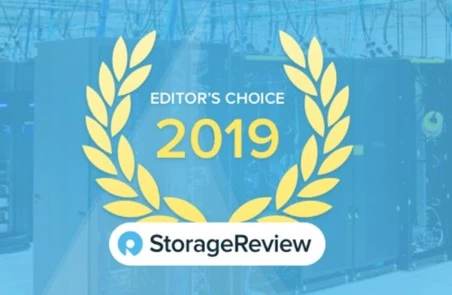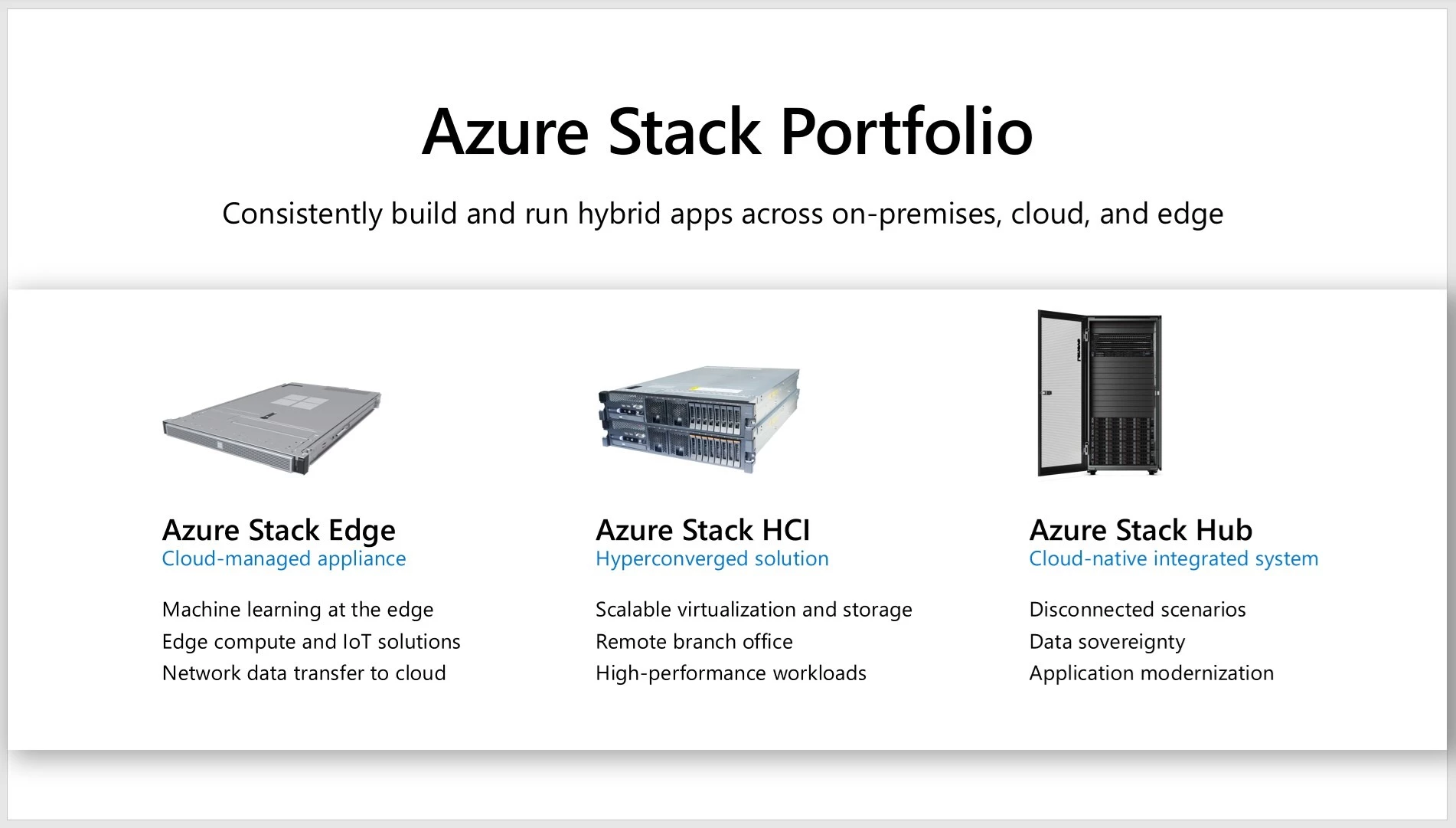Since announcing Azure Stack in 2017, we’ve set the stage for extending the cloud to customers’ datacenters. The hybrid cloud has been one of the design principles for Azure from the start. Today, customers including the Hong Kong Exchanges and Clearing Limited, KPMG Norway, Airbus, and the Malta Information Technology Agency are building hybrid solutions powered by Azure Stack that can run connected to or disconnected from public cloud to improve IT agility, maximize efficiency, and enable new business scenarios. 
Six months ago, we announced an addition to the Azure Stack family with Azure Stack HCI. Since then, enterprises are using Azure Stack HCI to modernize their datacenters, refresh and consolidate hardware and storage, and leverage Azure services, including Azure Site Recovery and Azure Backup, using Windows Admin Center. Businesses are running their mission-critical applications on one of the best performing systems in the category. According to StorageReview.com, “As seen in our numbers, the DataON cluster (in Azure Stack HCI) we’ve been testing has posted tremendous numbers, the fastest we’ve seen in a mid-market 4-node HCI cluster.” We now have over 150 solutions from 20 original equipment manufacturers (OEMs) in our Azure Stack HCI catalog.
Earlier this year, we also announced the general availability of Azure Data Box Edge, an AI-enabled edge computing appliance with Intel Arria 10 FPGA, to address innovative edge computing scenarios commonly found in retail, manufacturing, government, and other industries. For example, retail stores could use Azure Machine Learning capabilities in Data Box Edge to track inventory and modernize consumers’ retail experience.
As we continue to deepen our engagement with customers, we hear the need to meet different requirements ranging from deployment patterns (cloud-native, containers, virtual machines (VMs), managed services) to environmental conditions, regulatory environments, legacy and modern apps, capacity needs, and adoption curves.
Today, we’re excited to share new investments, capabilities, and form factors for the Azure Stack portfolio that ensure our edge infrastructure fits seamlessly in our customers’ solutions. With our news today, Azure Stack will expand to include a portfolio of products consisting of Azure Stack HCI, Azure Stack Hub (previously Azure Stack), and Azure Stack Edge (previously Azure Data Box Edge).
Azure Stack portfolio
Azure Stack portfolio is an extension of Azure to consistently build and run hybrid applications across datacenters, edge locations, remote offices, and cloud. Azure Stack provides customers choice and flexibility based on their solution needs from consistent hybrid cloud on-premises with Azure Stack Hub that can be connected or disconnected from public cloud, to high-performance virtualization on-premises with Azure Stack HCI or an Azure managed appliance that provides intelligent compute and AI at the edge with Azure Stack Edge.

Azure Stack Edge
Azure Stack Edge is an Azure managed appliance that brings the compute, storage, and intelligence of Azure to the edge. It is a first party Microsoft appliance, delivered to customers’ sites to run Azure services with no upfront costs (you pay monthly in your Azure bill). Customers can use the Azure portal to order and provision Azure Stack Edge; Azure management tools are used for monitoring and running updates. With Azure Stack Edge, you get a consistent experience across cloud and edge for everything, from developer tools to access control to workload management.
We are pleased to share that Azure Stack Edge will soon support new compute and AI capabilities including virtual machines, Kubernetes clusters, NVIDIA GPU support and high-availability support. With these capabilities, Azure Stack Edge is quickly evolving to the forefront of edge computing in the market. We are also enabling private cellular networks as a service by adding the tech preview of multi-access edge compute (MEC) on Azure Stack Edge.
Azure Stack Edge currently includes a Commercial series for enterprise datacenters or edge locations. Our Rugged series for sites with harsh environments will release soon, including the battery-powered form-factor we unveiled that can be carried in a backpack. The versatility of these Azure Stack Edge form-factors and cloud-managed capabilities brings cloud intelligence and compute to retail stores, factory floors, hospitals, field operations, disaster zones, and rescue operations.
Azure Stack HCI
To help our customers in making the most efficient choice for their HCI architecture, we are introducing an extension of the Azure Stack HCI program at Microsoft Ignite. With this addition to the Azure Stack HCI validation program, solutions can be optimized for many of the most popular workloads for HCI architecture: branch office and edge is focused on 2-node, resilient virtual and containerized applications, virtual desktop infrastructure to enable bring-your-own-device and protect corporate data, high-performance Microsoft SQL Server to provide optimized database operation in a virtual environment, trusted enterprise virtualization to leverage secure implementation guidance from hardware to OS, and scale-out storage to expand highly-available storage for remote storage implementations.
Solutions in the Azure Stack HCI catalog that have been optimized for these workloads will now show with a special designation in the catalog, making it easy for potential customers to identify the best choice for their workloads. Each of these workloads can be combined with a value-add service in Azure utilizing Windows Admin Center which makes deploying a connected hybrid solution with Azure Stack HCI very easy.
Responding to customer demand, additional workloads are in development, including general-purpose Kubernetes.
Azure Stack Hub
Azure Stack Hub will continue to be our cloud-native offering for enterprise and public sector customers, especially those interested in operating a cloud environment that is disconnected from public internet or meeting regulatory and compliance requirements. We’re sharing some new updates for Azure Stack Hub roadmap, including N-Series virtual machines enabled by NVIDIA V100 GPUs. We're also announcing the general availability of Kubernetes on Azure Stack Hub. You can now easily provision Kubernetes clusters on Azure Stack Hub using Azure Kubernetes Service (AKS) engine to automate the creation, update, and scaling of Kubernetes clusters. In the first half of 2020, Event Hubs and Azure Stream Analytics will also be available for public preview.
Azure Arc and the Azure Stack portfolio
At Microsoft Ignite, we announced a preview of Azure Arc to bring Azure services and management to any infrastructure. With Azure Arc, you can deploy Azure SQL Databases on any Kubernetes cluster. Azure Arc and Azure Stack portfolio are complementary. You can combine the benefits of Azure Arc with Azure Stack portfolio where Azure Arc can manage virtual machines, containers, and run Azure Data Services on Azure Stack portfolio of validated and integrated systems while leveraging the compute and cloud capabilities of Azure Stack.
We have a busy Ignite for you, including 12 sessions dedicated to our Azure Stack portfolio, several expo booths and partner exhibits. We also partnered with Intel to demonstrate an intelligent retail experience at Ignite 2019 expo floor, so come and visit!
Azure. Invent with purpose.
